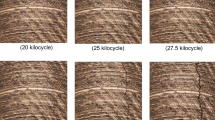Abstract
We present a novel context-driven approach to image-based crack detection for automated inspection of aircraft surface and subsurface defects. In contrast to existing image-based crack detection methods, which rely mostly on low-level image processing and data-driven methods, our method explicitly incorporates multiple high-level context into low-level processing. We present two classes of context: geometric/structural context and physical context. We formulate mathematically a sparse decomposition problem to incorporate the context and apply robust principal component analysis to decompose typical repetitive rivet regions into a normal component and a sparse component. Cracks are detected in the sparse component. By applying the proposed context-driven approach to coated and uncoated test specimens, we achieve significant reduction in false detections compared to the approach without exploiting context.










Similar content being viewed by others
References
Candès, E., Li, X., Ma, Y., Wright, J.: Robust principal component analysis? J. ACM 58(3), 1–37 (2011)
Cević, I.J., Orteu, J.-J., Sentenac, T., Gilblas, R.: Automated visual inspection of an airplane exterior. In:Proceedings of the SPIE 9534, Twelfth International Conference on Quality Control by Artificial Vision, vol. 9534 (2015)
Chambon, S., Moliard, J.: Automatic road pavement assessment with image processing: review and comparison. Int. J. Geophys. 2011, 1–28 (2011)
Dai-Heng, C., Hironobu, N.: Detection of a crack by body force method. Eng. Fract. Mech. 45(5), 671–685 (1993)
Farrar, R.R., Worden, K.: Structural Health Monitoring: A Machine Learning Perspective. Wiley, New York (2012)
Gordon, R.O.: 43-204—Visual Inspection for Aircraft. AFS-350, U.S. Department of Transportation (1997)
Gunatilake, P., Siegel, M., Jordan, A., Podnar, G.: Image understanding algorithms for remote visual inspection of aircraft surfaces. In: Machine Vision Applications in Industrial Inspection V, vol. 3029, pp. 2 – 13 (1997)
Heoppner, D.W.: The Role of Fretting Fatigue on Aircraft Rivet Hole Cracking. Federal Aviation Administration, Office of Aviation Research (1996)
Illingworth, J., Kittler, J.: Survey of the hough transform. Comput. Vis. Graph. Image Process. 44(1), 87–116 (1988)
Jahanshahi, M.R., Kelly, J.S., Masri, S.F., Sukhatme, G.S.: Survey and evaluation of promising approaches for automatic image-based defect detection of bridge structures. Struct. Infrastruct. Eng. 5(6), 455–486 (2009)
Jahanshahi, M.R., Masri, S.F., Padgett, C.W., Sukhatme, G.S.: An innovative methodology for detection and quantification of cracks through incorporation of depth perception. Mach. Vis. Appl. 24(2), 227–241 (2013)
Lin, Z., Chen, M., Ma, Y.: The Augmented Lagrange Multiplier Method for Exact Recovery of Corrupted Low-Rank Matrices. UIUC Tech. Report UILU-ENG-09-2214 (2010)
Lowe, D.G.: Object recognition from local scale-invariant features.In: Proceedings of the International Conference on Computer Vision, pp. 1150–1157 (1993)
Mumtaz, R., Mumtaz, M., Mansoor, A.B., Masood, H.: Computer aided visual inspection of aircraft surfaces. Int. J. Image Process. 6(1), 38–53 (2012)
Nguyen, H., Kam, T.Y., Cheng, P.Y.: Crack image extraction using a radial basis functions based level set interpolation technique. In: IEEE International Conference on Computer Science and Electronics Engineering (ICCSEE), pp. 118–122 (2012)
Oliveira, H., Correia, P.: Automatic road crack detection and characterization. IEEE Trans. Intell. Transp. Syst. 14(1), 155–168 (2013)
Schmugge, S.J., Rice, L., Nguyen, N.R., Lindbergy, J., Grizziy, R., Joffey, C., Shin, M.C.: Detection of cracks in nuclear power plant using spatial-temporal grouping of local patches. In: Proceedings of the WACV 2016, IEEE Winter Conference on Applications of Computer Vision (2016)
Scholz-Reiter, B., Weimer, D., Thamer, H.: Automated surfaceinspection of cold-formed micro-parts. CIRP Ann.Manuf. Technol. 61, 531–534 (2012)
Shahraray, B., Schmidt, A., Palmquist, J.: Defect detection, classification and quantification in optical fiber connectors. In: IAPR Workshop on Machine Vision Applications, pp. 15–22 (1990)
Siegel, M., Gunatilake, P.: Enhanced remote visual inspection of aircraft skin. In: Intelligent NDE Sciences for Aging and Futuristic Aircraft (1997)
Staszewski, W., Boller, C., Tomlinson, G.: Health Monitoring of Aerospace Structures: Smart Sensor Technologies and Signal Processing. Wiley, New York (2004)
Strat, T.M.: Employing contextual information in computer vision. In: ARPA Image Understanding Workshop (1993)
Sumi, N., Taguchi, R., Hattori, K., Hoguro, M., Umezaki, T.: Automatic visual inspection system of fasteners for aircraft using 3d measuring. J. Jpn. Soc. Precis. Eng. 81(12), 1140–1145 (2015)
Sutton, M.A., Orteu, J.-J., Schreier, H.W.: Image Correlation for Shape, Motion and Deformation Measurements: Basic Concepts, Theory and Applications. Springer, Berlin (2009)
Weimer, D., Thamer, H., Scholz-Reiter, B.: Learning defectclassifiers for textured surfaces using neural networks andstatistical feature representations. In: 46th CIRP Conference on Manufacturing Systems, pp. 347–352 (2013)
Yamaguchi, T., Hashimoto, S.: Fast crack detection method for large-size concrete surface images using percolation-based image processing. Mach. Vis. Appl. Special Issue Integr. Imaging Vis. Tech. Ind. Insp. 21(5), 797–809 (2010)
Zhang, Z., Ganesh, A., Liang, X., Ma, Y.: TILT: transform invariant low-rank textures. Int. J. Comput. Vis. 99(1), 1–24 (2012)
Author information
Authors and Affiliations
Corresponding author
Additional information
The work was done while the first author was affiliated with United Technologies Research Center (UTRC), East Hartford, Connecticut, USA.
Rights and permissions
About this article
Cite this article
Wang, H., Xiong, Z., Finn, A.M. et al. A context-driven approach to image-based crack detection. Machine Vision and Applications 27, 1103–1114 (2016). https://doi.org/10.1007/s00138-016-0779-1
Received:
Revised:
Accepted:
Published:
Issue Date:
DOI: https://doi.org/10.1007/s00138-016-0779-1




